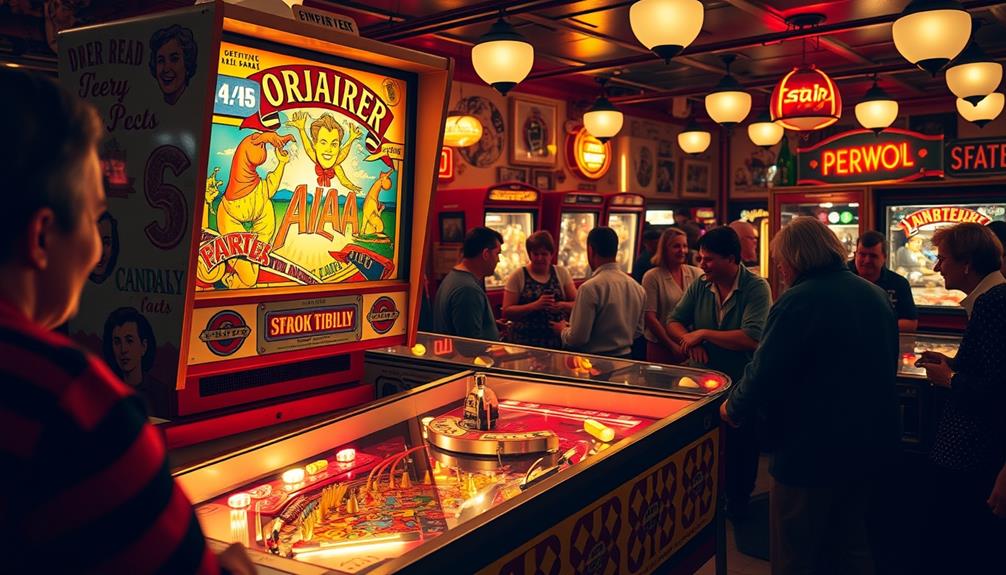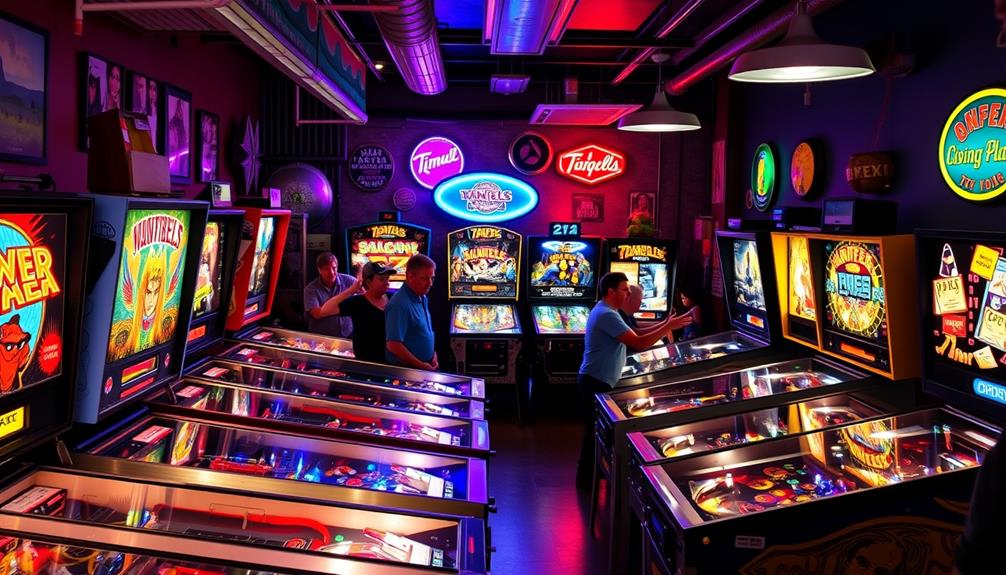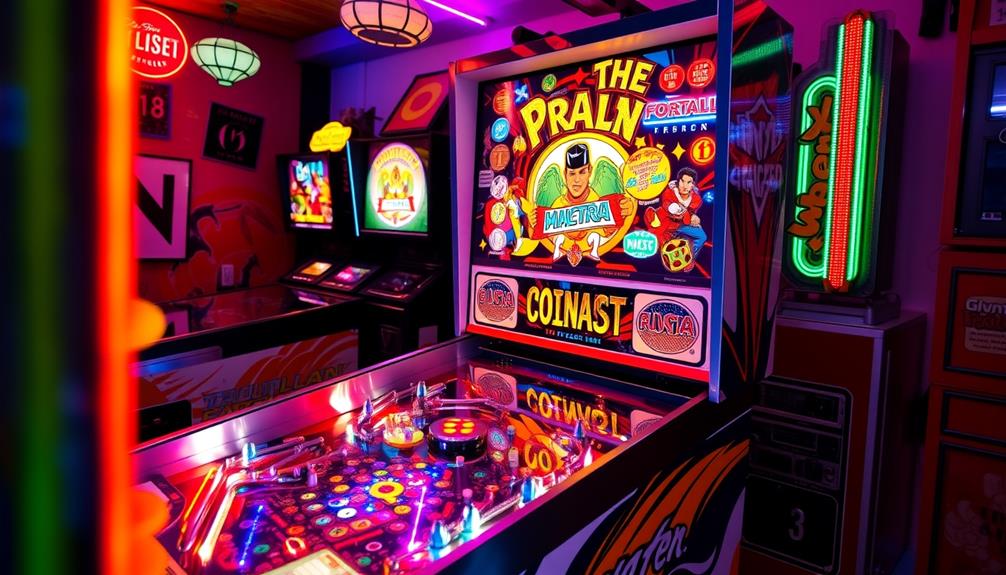Pinball machines trace their origins back to the late 18th century, stemming from a game known as Bagatelle. Although Montague Redgrave patented a spring-loaded version in 1871, it wasn’t until 1931 that the first coin-operated game, Ballyhoo, made its debut. The term “pinball” was established in 1936, solidifying the game’s identity. The introduction of flippers in the late 1940s marked a significant innovation, shifting gameplay from luck to skill. Fast forward to the present day, and you’ll discover a vibrant pinball culture that continues to thrive. Interested in the game’s evolution? You’ll uncover a wealth of intriguing details ahead! The first pinball machine to integrate electronic components was introduced in 1963, ushering in a new era of inventive features and designs. From themed machines to elaborate artwork and sound effects, the progression of pinball has been a testament to its enduring popularity. As retro arcades and dedicated pinball bars gain popularity, the game maintains its timeless allure, captivating players of all ages.
Key Takeaways
- The precursor to pinball, Bagatelle, emerged in the late 18th century, featuring a slanted board and scoring pockets.
- Montague Redgrave patented an improved Bagatelle in 1871, introducing a spring-loaded plunger and smaller marbles.
- The first coin-operated pinball game, Ballyhoo, was launched in 1931, marking a significant milestone in gaming.
- The term "pinball" was officially coined in 1936, establishing the game's identity in popular culture.
- The introduction of flippers in 1947 transformed pinball gameplay from chance to skill-based interactions, revolutionizing the industry.
Origins of Pinball Machines
In the late 18th century, the roots of pinball machines began to take shape with the game Bagatelle, where players used a cue stick to hit balls into scoring pockets on a slanted board. This early game of chance set the stage for future developments in pinball history.
Curiously, similar to how astrological signs may influence perceptions of beauty, the allure of pinball has captivated players with its engaging design and mechanics.
In 1871, Montague Redgrave patented an improved version of Bagatelle, incorporating a spring-loaded plunger mechanism and smaller marbles, which laid the groundwork for modern pinball machines.
Fast forward to 1931, when the first coin-operated pinball game, Ballyhoo, emerged, marking a significant shift from manual to coin-operated gaming.
The term "pinball" was officially coined in 1936, solidifying the game's identity as it evolved.
A major turning point arrived in 1947 with the introduction of flippers in the game Humpty Dumpty. This innovation revolutionized gameplay, altering the dynamics from mere chance to skill-based interactions, enhancing player engagement.
As these changes unfolded, pinball machines became increasingly popular, leading to the vibrant and complex games we recognize today.
Understanding these origins helps you appreciate the evolution of this beloved pastime.
Key Innovations in Design
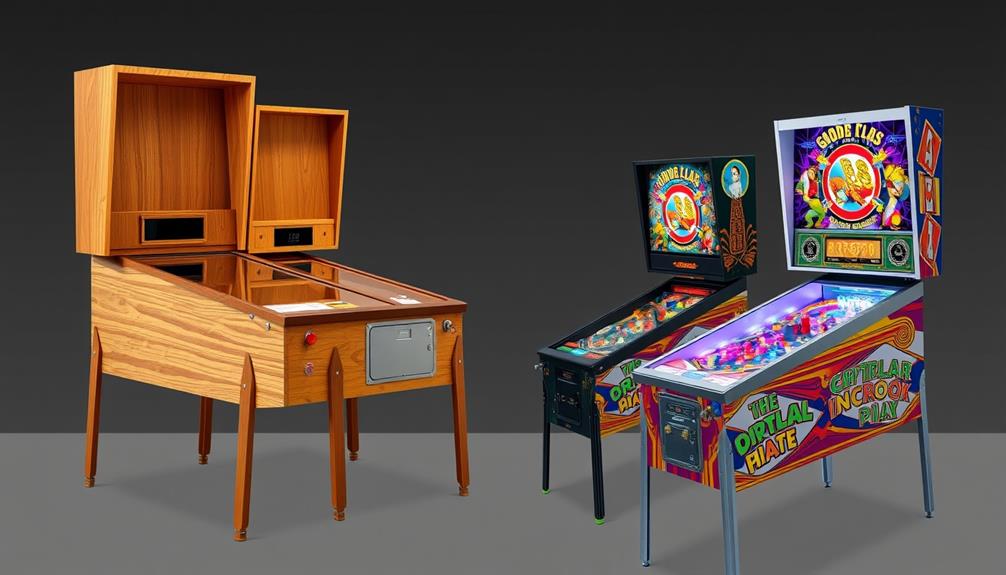
Pinball's evolution owes much to key innovations in design that transformed it into the engaging game we recognize today. The journey began with Raymond Maloney's creation of Ballyhoo in 1932, the first modern coin-operated pinball machine. This marked a pivotal moment in gaming history, similar to how a budget plan is essential for managing finances effectively.
Several innovations have shaped pinball machines over the decades, including:
- The flipper: Introduced in 1947 with Gottlieb's Humpty Dumpty, it shifted pinball from a game of chance to a game of skill.
- Electrically powered machines: Launched in 1933, these enhanced gameplay with sound effects and lights, adding excitement to each game.
- Solid-state electronics: By 1975, Micro's Spirit of 76 introduced microprocessors, allowing for advanced features and more complex scoring systems.
The addition of animatronics and interactive elements, as seen in Stern's Jurassic Park, showcases how game designers continue to push the boundaries of pinball.
These innovations not only improve player engagement but also create immersive experiences that keep you coming back for more.
With each advancement, pinball machines evolve, ensuring their place in arcade history.
The Rise of Coin-Operated Machines
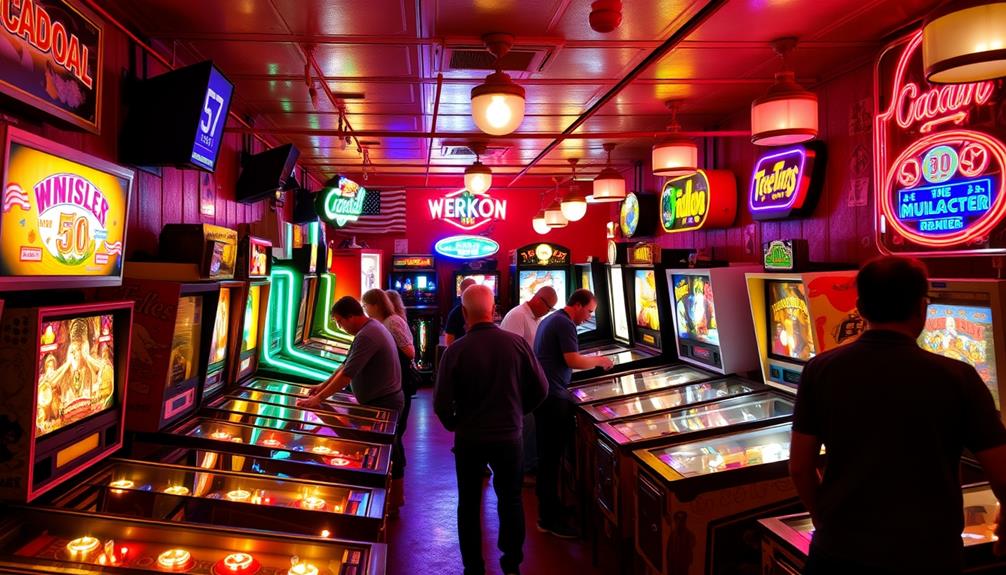
The rise of coin-operated machines marked a turning point in the gaming industry, transforming pinball from a simple pastime into a widely popular form of entertainment.
In 1931, Raymond Maloney introduced Ballyhoo, the first coin-operated pinball machine, setting the stage for the commercialization of this exciting game. This shift not only increased accessibility but also enhanced user experience, as high-quality content boosts credibility and trustworthiness.
Before this innovation, early pinball games like Bingo and Baffle Ball laid the groundwork, but it was the introduction of coin-operated machines that truly captured the public's interest.
By 1936, the term "pinball" became widely recognized, solidifying its identity within the gaming market.
The addition of electromechanical components in the 1930s further enhanced the gameplay experience, making machines more engaging and immersive.
This technological leap fueled the popularity of coin-operated machines, leading to a flourishing pinball industry.
The Impact of World War II
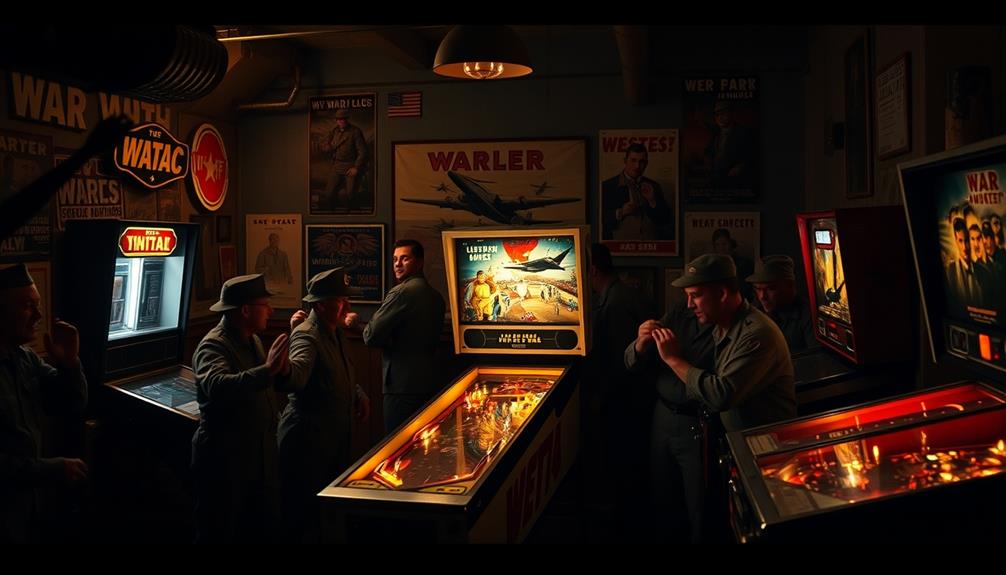
Frequently, major global events reshape industries, and World War II was no exception for pinball machines. During the early 1940s, production shifted dramatically from consumer entertainment to military supplies. This shift led to a significant decline in the manufacturing of pinball machines, as materials like wood and metal became scarce.
The financial implications of this change were profound, as manufacturers faced challenges similar to those seen in divorce financial considerations, impacting their ability to recover post-war.
The aftermath of the war marked a turning point for the industry. Soldiers returning home sought recreational activities, fueling a revival in the popularity of pinball. The post-war economic expansion created an ideal environment for the resurgence of arcades and bars featuring these machines.
Here are a few key impacts of World War II on the pinball industry:
- Manufacturing of pinball machines declined sharply during the war.
- The post-war era saw a boom in the arcade scene.
- Legal changes, influenced by the war, helped establish pinball as a game of skill.
The California Supreme Court's ruling in 1974, which classified pinball as a game of skill rather than chance, further solidified its mainstream acceptance.
The Golden Age of Pinball

You might find it fascinating that the Golden Age of Pinball spanned from the late 1940s to the early 1970s, revolutionizing the game with the introduction of flippers.
This innovation transformed pinball from pure chance into a skill-based challenge, leading to a surge in popularity.
As AI-driven storytelling techniques began to enhance various forms of entertainment, iconic coin-operated machines emerged, players became more engaged than ever, marking a significant shift in the arcade landscape.
Early Coin-Operated Machines
During the early 1930s, the landscape of entertainment shifted dramatically with the advent of coin-operated machines, marking the beginning of what would become the Golden Age of pinball. The first pinball machine, Ballyhoo, developed by Raymond Maloney in 1932, played a pivotal role in this evolution.
Early coin-operated machines like Bingo and Baffle Ball captivated players, with Baffle Ball selling over 400 units daily. This era's innovations also paralleled advancements in other entertainment technologies, showcasing the growing reliance on mechanical games for leisure, akin to the impact of a major Microsoft outage on businesses today.
Key developments during this time included:
- Introduction of electrically powered machines: These advanced games brought sound effects and lights, enhancing the gameplay experience.
- The tilt mechanism: Invented in 1934, this feature prevented players from cheating by shaking the machine and notably influenced gameplay dynamics.
- Coining the term "pinball": In 1936, the term solidified the identity of these games as a unique form of entertainment.
As you explore the history of pinball machines, it's fascinating to see how these innovations laid the groundwork for the vibrant pinball culture that would follow.
These early developments not only defined the era but also set the stage for future innovations in the pinball industry.
Flipper Mechanism Innovation
As pinball machines evolved, the introduction of the flipper mechanism in 1947 marked a pivotal moment in gameplay, transforming how players interacted with the game. With the release of "Humpty Dumpty," designed by Harry Mabs and Wayne Neyens, you gained control over the ball's trajectory, shifting pinball from pure luck to skill-based play. This innovation made the game more engaging and competitive in arcades, much like how silly tantrums often occur during family photoshoots, adding a layer of humor to the experience.
The introduction of two outward-facing flippers in 1950, known as "Triple Action" and designed by Steve Kordek, further enhanced player interaction. You could now execute precise shots and strategies, increasing the game's complexity.
Later that same year, Gottlieb's "Just 21" became the first machine to feature inward-facing flippers, allowing for a unique style of gameplay that demanded even more finesse.
During the Golden Age of Pinball in the 1950s and 1960s, the success of flipper-equipped machines led to widespread adoption of this feature.
Today, the flipper mechanism remains a cornerstone of pinball design, ensuring that every game is an exciting blend of skill and innovation, keeping players coming back for more.
Rise of Popularity
In the late 1940s to early 1970s, pinball machines skyrocketed in popularity, enchanting audiences in bars, arcades, and recreational venues across the country. This era, known as the Golden Age of Pinball, marked a significant shift in gameplay due to the introduction of flippers in 1947.
With this innovation, players engaged more skillfully, moving beyond mere chance. During this time, several factors contributed to the rise of pinball machines, including the excitement of healthy dog snacks for happy pets that kept players energized for longer gaming sessions.
The release of "Humpty Dumpty," the first commercially successful machine featuring six flippers. The proliferation of electromechanical (EM) pinball machines, which introduced multiball play and increased gameplay complexity. The advent of digital scoring and solid-state electronics in the late 1970s, sparking renewed interest in iconic machines like "Eight Ball."
Pinball machines became cultural icons, appearing in movies and television shows while fostering competitive tournaments.
This period solidified pinball's place in American entertainment, as these machines transformed from simple games to beloved staples, enchanting players and audiences alike. The Golden Age of Pinball truly represents a vibrant chapter in gaming history.
The Modern Pinball Resurgence
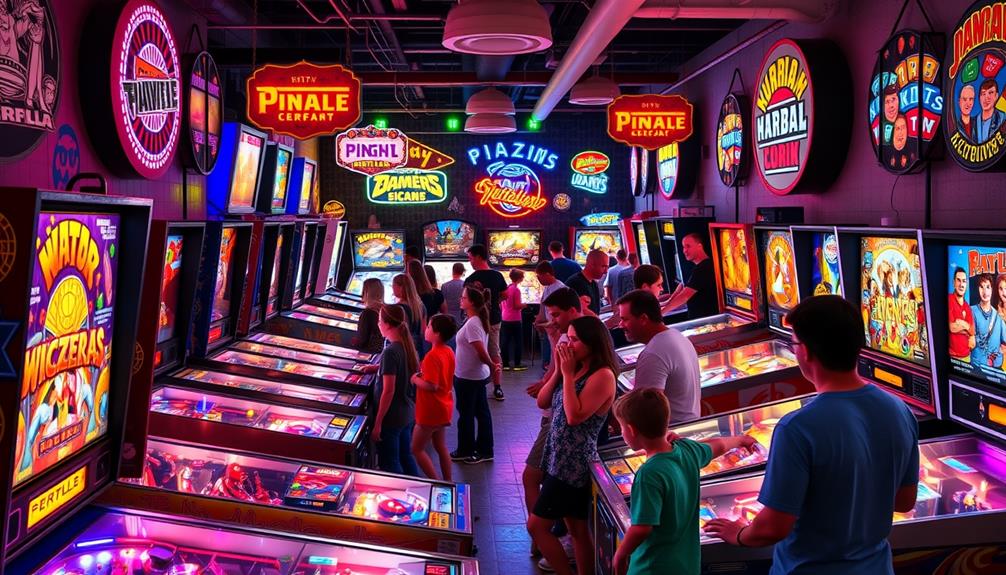
Revitalized by a wave of nostalgia and a craving for tactile experiences, pinball machines have seen a remarkable resurgence since the early 2000s. This revival is fueled by a growing interest in retro gaming and the unique mechanical gameplay that sets pinball apart from digital games.
New manufacturers like Jersey Jack Pinball emerged, launching innovative titles such as "The Wizard of Oz," which features advanced technology and vibrant displays. The building and legal considerations for tiny houses highlight how innovation can transform classic concepts into modern experiences, much like the evolution of pinball machines.
The rise of competitive pinball tournaments and leagues has fostered community engagement, allowing players of all skill levels to connect and share their passion. Events and trade shows dedicated to pinball culture have also gained popularity, showcasing the latest trends and innovations.
With modern pinball machines incorporating LED lighting and interactive themes, they've attracted diverse audiences, making them a staple in arcades and home collections.
These developments demonstrate that pinball isn't just a relic of the past; it's an evolving form of entertainment that continues to captivate players. Whether you're a seasoned pro or a newcomer, the modern pinball scene offers something for everyone.
Frequently Asked Questions
Were Pinball Machines Illegal in the 70S?
Yes, pinball machines were illegal in many places during the 1970s due to perceptions of gambling. However, as legal battles progressed, more cities lifted their bans, allowing pinball to thrive again in entertainment venues.
When Did Pinball Machines Become Popular?
Ever wondered when pinball machines took off? They became popular in the 1930s, thriving as affordable entertainment during the Great Depression. By the '40s, you'd find them everywhere—bars, arcades, and more, enchanting players everywhere.
Why Was Pinball Illegal?
Pinball was illegal because many saw it as a gambling device, fueling fears about organized crime. Concerns over its classification as a game of chance led to bans in major cities during the mid-20th century.
Was Pinball Popular in the 70S?
Imagine an arcade buzzing with excitement—pinball machines ruled the scene in the 70s! You'd see crowds drawn to innovative gameplay, iconic titles, and tournaments, all fueling pinball's rise as a cultural phenomenon.
Conclusion
So, whether you're reminiscing about the clattering sounds of a vintage machine or discovering a sleek modern game at a bar, pinball's journey from simple origins to a beloved pastime connects us all. Isn't it funny how you can stumble upon a pinball machine just when you need a break? As you flip those flippers, you're not just playing; you're part of a rich history that brings joy and nostalgia to countless players, just like you.
